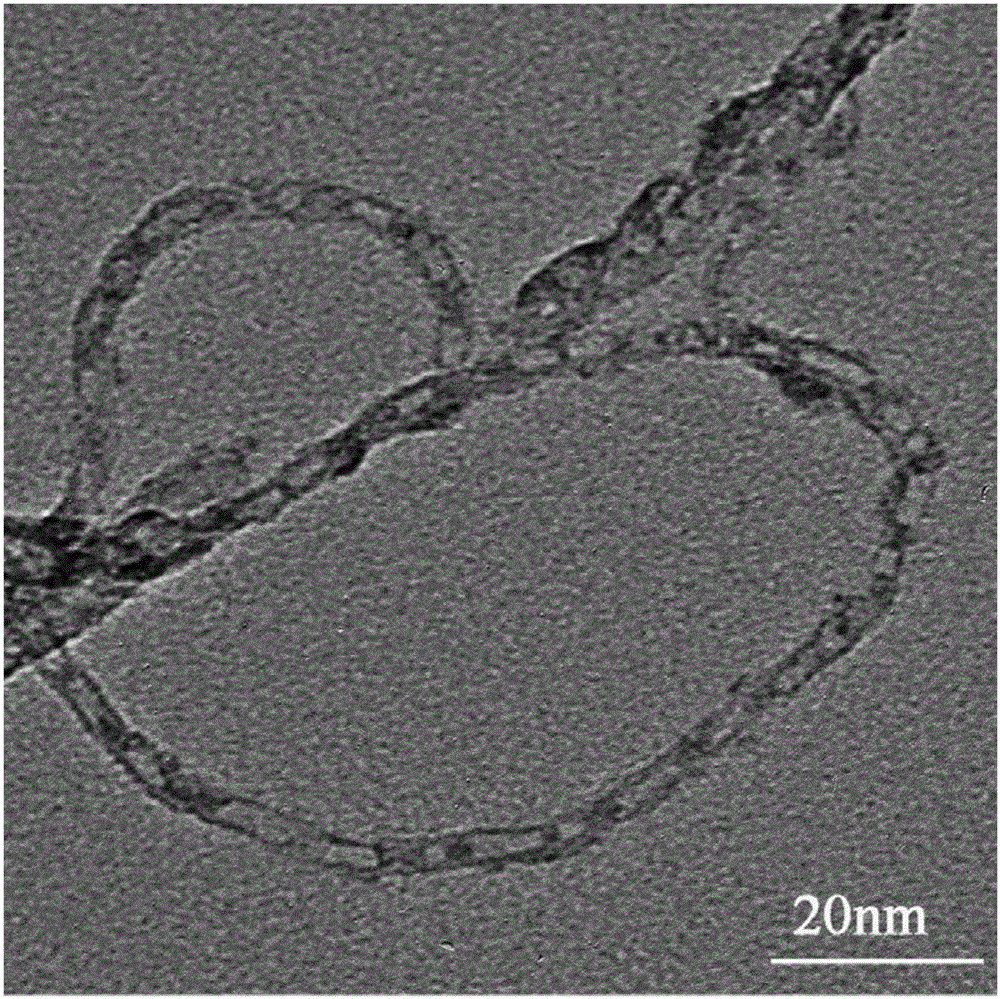Preparation method for carbon nanotube-coated thermoelectric nanometer capsule
A technology of carbon nanotubes and nanocapsules, which is applied in the field of preparation of thermoelectric nanocapsules, can solve problems such as lack of thermoelectric materials, achieve rapid response, simple process flow, and improve thermoelectric performance
- Summary
- Abstract
- Description
- Claims
- Application Information
AI Technical Summary
Problems solved by technology
Method used
Image
Examples
Embodiment 1
[0021] 1) Ultrasonic dispersion of 0.024 g of functionalized carbon nanotubes in ethylene glycol was transferred to a 100 ml three-neck round bottom flask, and the pH was adjusted to 12. The functionalization method of carbon nanotubes is: heat the carbon nanotubes in concentrated nitric acid to 120°C, oxidize, purify, wash with deionized water until neutral, remove impurities, and then ultrasonically disperse the carbon nanotubes in concentrated ammonia water 2h, after washing again to neutrality, placed in a concentrated solution of EDTA and ultrasonically oscillated for 2h to complete the functionalization treatment.
[0022] 2) Weigh a certain amount of Bi(NO 3 ) 3 ·5H 2 O, dissolved in ethylene glycol and heated to make a 10mmol / l solution.
[0023] 3) Weigh a certain amount of Na 2 TeO 3 , dissolved in ethylene glycol, and heated to make a 20mmol / l solution.
[0024] 4) According to Bi 2 Te 3 The determined Bi:Te molar ratio of chemical composition is 2:3, the Bi...
Embodiment 2
[0028] 1) Ultrasonic dispersion of 0.063 g of functionalized carbon nanotubes in ethylene glycol was transferred to a 100 ml three-neck round bottom flask, and the pH was adjusted to 13. The functionalization method of carbon nanotubes is: heat the carbon nanotubes in concentrated nitric acid to 120°C, oxidize, purify, wash with deionized water until neutral, remove impurities, and then ultrasonically disperse the carbon nanotubes in concentrated ammonia water 2h, after washing again to neutrality, placed in a concentrated solution of EDTA and ultrasonically oscillated for 2h to complete the functionalization treatment.
[0029] 2) Weigh a certain amount of SbCl 3 , Dissolved in ethylene glycol, and heated to make a 10mmol / l solution.
[0030] 3) Weigh a certain amount of Na 2 TeO 3 , dissolved in ethylene glycol, and heated to make a 20mmol / l solution.
[0031] 4) According to Sb 2 Te 3 The molar ratio of Sb:Te determined by chemical composition is 2:3, the SbCl of 20.0...
Embodiment 3
[0035] 1) Ultrasonic dispersion of 0.144 g of functionalized carbon nanotubes in ethylene glycol was transferred to a 100 ml three-neck round bottom flask, and the pH was adjusted to 14. The functionalization method of carbon nanotubes is: heat the carbon nanotubes in concentrated nitric acid to 120°C, oxidize, purify, wash with deionized water until neutral, remove impurities, and then ultrasonically disperse the carbon nanotubes in concentrated ammonia water 2h, after washing again to neutrality, placed in a concentrated solution of EDTA and ultrasonically oscillated for 2h to complete the functionalization treatment.
[0036] 2) Weigh a certain amount of SbCl 3 , Dissolved in ethylene glycol, and heated to make a 10mmol / l solution.
[0037] 3) Weigh a certain amount of Se powder, dissolve it in ethylene glycol, and heat it to make a 20mmol / l solution.
[0038] 4) According to Sb 2 Se 3 The molar ratio of Sb:Se determined by chemical composition is 2:3, the SbCl of 20.0ml ...
PUM
 Login to View More
Login to View More Abstract
Description
Claims
Application Information
 Login to View More
Login to View More - R&D
- Intellectual Property
- Life Sciences
- Materials
- Tech Scout
- Unparalleled Data Quality
- Higher Quality Content
- 60% Fewer Hallucinations
Browse by: Latest US Patents, China's latest patents, Technical Efficacy Thesaurus, Application Domain, Technology Topic, Popular Technical Reports.
© 2025 PatSnap. All rights reserved.Legal|Privacy policy|Modern Slavery Act Transparency Statement|Sitemap|About US| Contact US: help@patsnap.com


